
在本章中,我们将研究如何向场景添加光源以及如何对场景中的物体进行光照计算。
本章的标题是“着色”,而不是光照,这是两个不同但又密切相关的概念。本书光照(illumination) 是为了计算光对场景中单个点的影响所需的数学知识和算法,而 着色(shading)是 将光对一组离散点的影响扩展到整个物体的技术。
第三章,我们需要了解的有关光照的所有信息,我们可以定义环境光、点光、方向光,并且我们可以在已知点的位置和该点的表面法线的前提下,计算场景中任何点的光照,

上面光照方程表示光如何照亮场景中的一个点,i 表示第i个光源。该方程在我们的 光线追踪渲染器 中的工作方式与它在光栅化渲染器中的工作方式完全相同。
在本章中探讨更有趣的部分是如何将 “在一点的光照” 算法扩展为 “三角形上每个点的光照” 算法。
因为可以计算某一点的光照,我们可以选择三角形中的任意一点(例如,它的中心),计算该点的光照,然后用它对整个三角形进行着色。要进行实际着色,我们可以用三角形的颜色乘这个光照计算值。
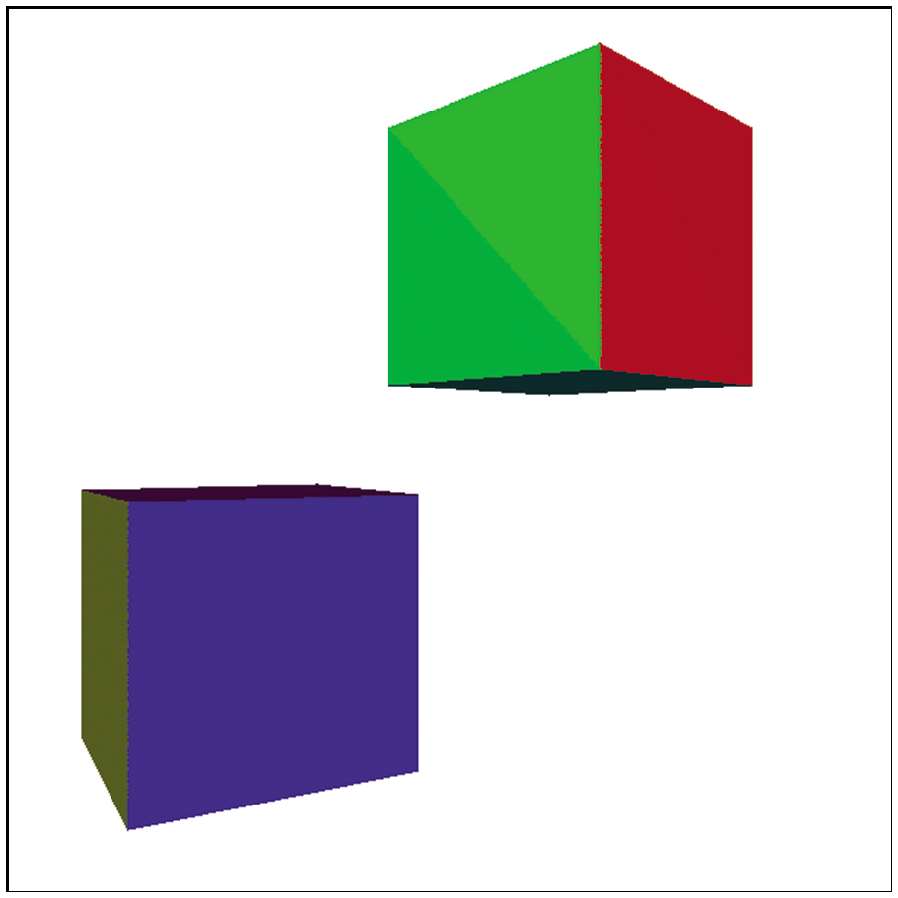
渲染结果已经朝着我们希望的方向发展,三角形中的每个点都有相同的法线,只要光源离它足够远,每个点的光向量就近似平行,并且每个点接收到的光量也近似相同。可以看到构成立方体每个面的两三个三角形之间的不连续效果,这是光向量近似而不完全平行的结果,不同三角形中心到光源直间只有夹角的。
如果对每个点都有不同法线的物体,如球,尝试使用这种技术,会发生什么。
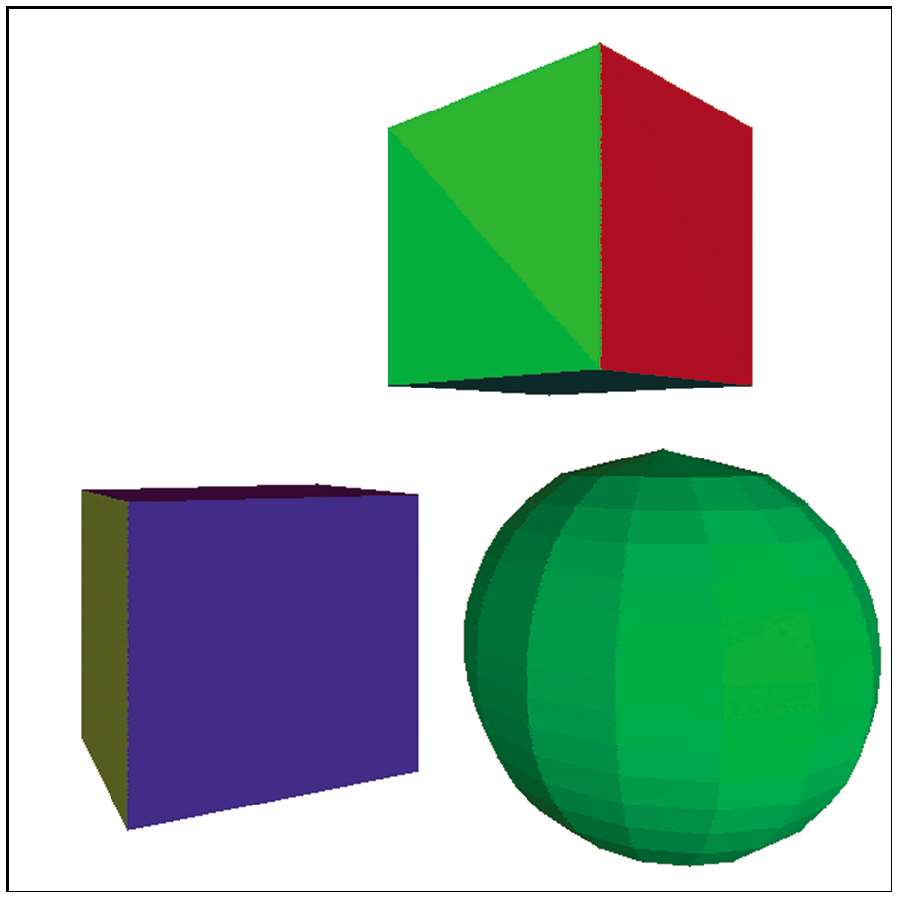
效果不太好,很明显,这个物体不是一个真正的球体,而是一个由扁平的三角形块构成的近似结果。因为这种光照使弯曲的物体看起来是扁平的,所以它被称为 扁平化着色 (flat shading)。
怎么才能消除光照中的不连续现象呢,我们可以计算三角形3个顶点的光照,而不是只计算三角形中心的光照。
这给了我们3个介于0.0 和 1.0 之间的光照值,每个光照值对应于三角形的一个顶点。使用光照值作为“强度”属性。
这种技术被称为 高洛德着色(Gouraud shading)。以 亨利 高洛德(Henri Gouraud)的姓命名,他在1971年提出。
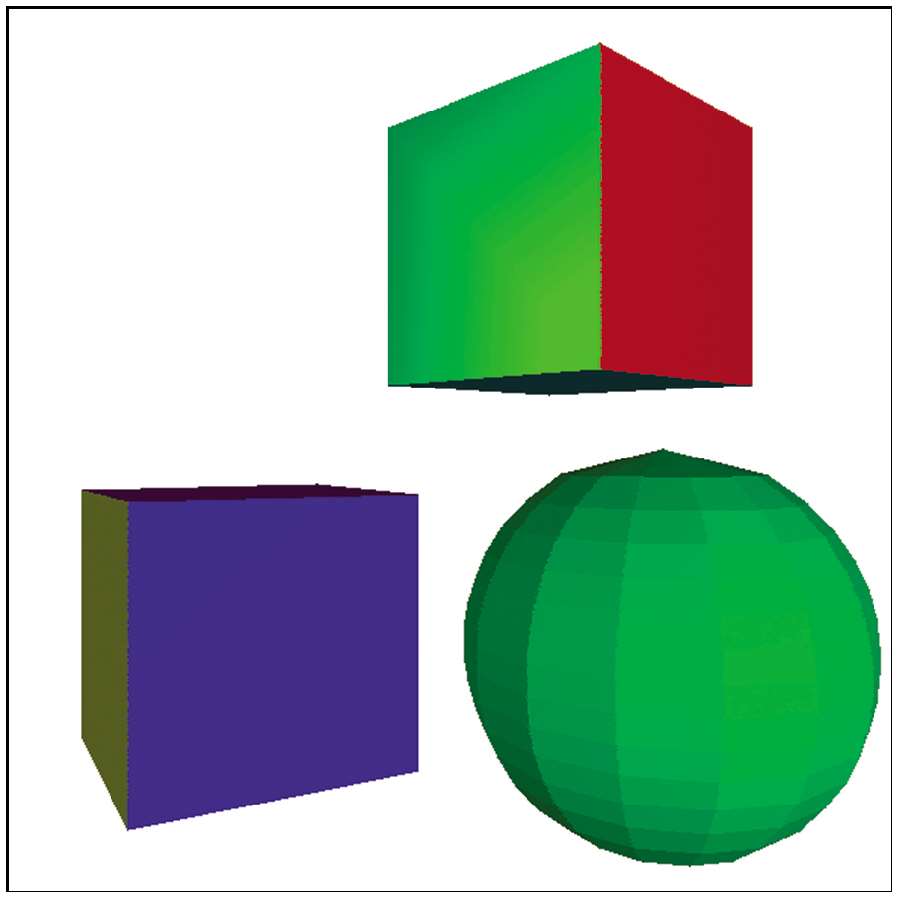
立方体看起来比之前更好了,不连续现象消失了,因为每个面的两个三角形共享两个顶点并且它们具有相同的法线,因此这两个顶点的光照对于两个三角形是相同的。
球体表面看起来仍然是有多个面的,尽管每个三角形都与其相邻三角形共享顶点,但它们有不同的法线。
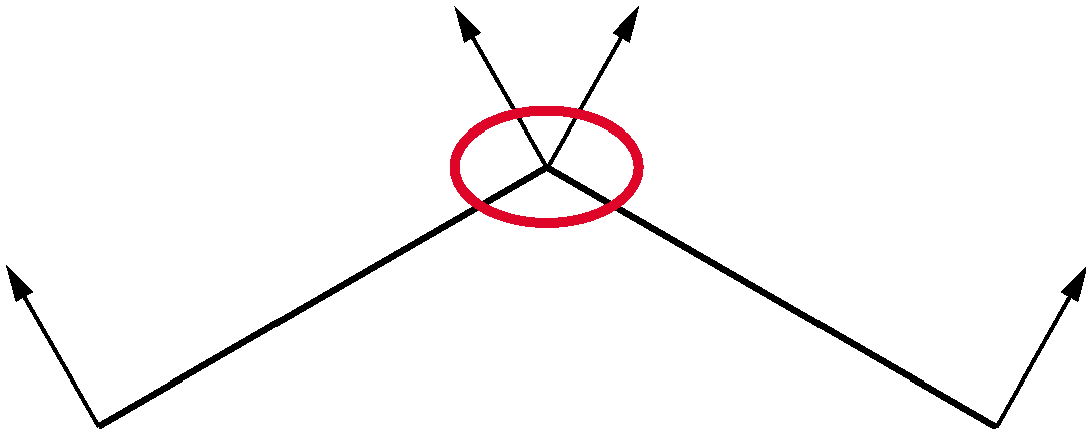
可以进行优化
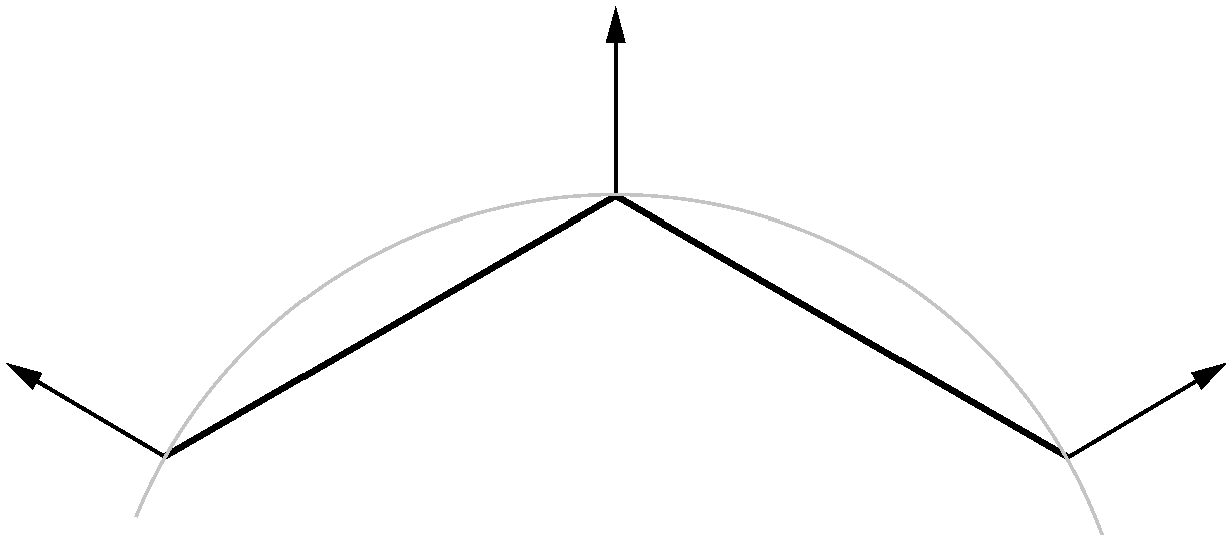
这种近似方法不适用于立方体,即使三角形共享顶点位置,每个面也需要独立于其他面进行着色,立方体的顶点没有单一的“正确”法线。
将法线称为三角形的属性,相关模型设置如下所示:
model {
name = cube
vertices {
0 = (-1, -1, -1)
1 = (-1, -1, 1)
2 = (-1, 1, 1)
...
}
triangles {
0 = {
vertices = [0, 1, 2]
normals = [(-1, 0, 0), (-1, 0, 0), (-1, 0, 0)]
...
}
}
}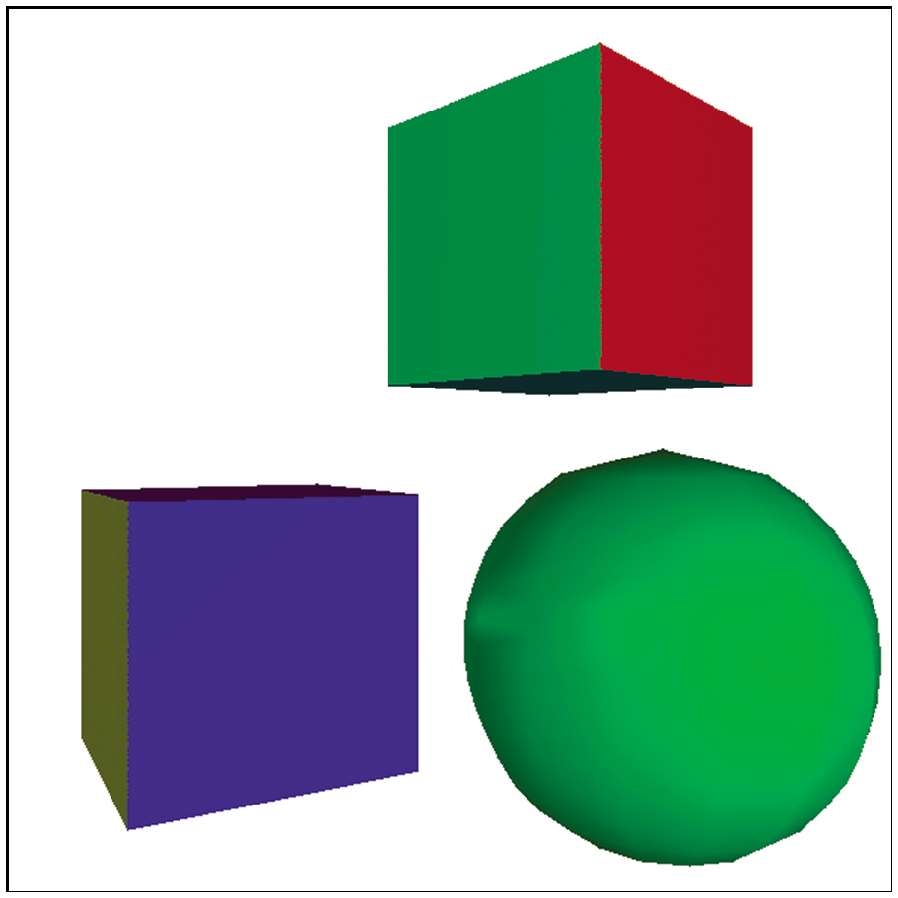
立方体看起来仍然像立方体,球体现在看起来非常像一个球体。事实上,只能通过观察它的轮廓来判断它是由三角形构成的。这可以通过使用 更多、更小的三角形来改善,但代价是需要更多的计算资源。
然而,当渲染闪亮的物体时,高洛德着色开始“崩溃”,球体上的镜面高光显然是不符合现实的。
当我们把点光源靠近一个大的表面时,我们自然会期望它看起来更亮并且镜面反射效果变得更加明显。然而,高洛德着色产生了完全相反的结果:
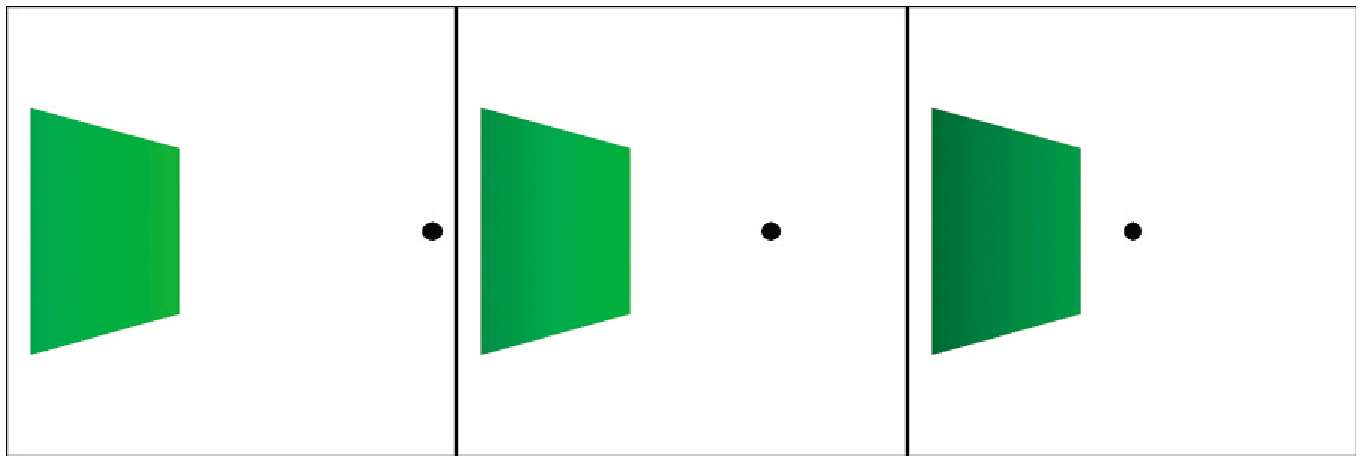
我们期望三角形中心附近的点会接收到大量光线,因为L和N大致平行。然而,我们不是在三角形的中心计算光照,而是在它的顶点,在这些顶点上,光源离表面越近,它的法线的角度就越大,因此这些顶点接收到的光照就越少。这意味着每个内部像素最终都会得到一个强度值,该值是在两个非常小的值之间进行插值的结果,该值也是一个很小的值。

扁平化着色在每个三角形上只涉及1次光照计算。高洛德着色需要每个三角形进行3次光照计算,加上一个单独的属性(整个三角形的光照)的插值。下一步关于渲染质量的提升要求我们 计算三角形每个像素的光照。
回想一下,包含 环境光、漫反射、镜面反射 分量的完整光照方程是下面这样的:

需要明确L, 对于方向光,L是已知的。对于点光源,L被定义为从场景中的点P到光源位置Q的向量。然而,并不是三角形的每个像素都有Q,而是只有顶点有Q。
我们所拥有的是点P的投影,也就是我们将要在画布上绘制的 x’ 和 y’ 我们已知如下等式:
x' = xd/z
y' = yd/zx' = xd (1/z)
y' = yd (1/z)可以从这些值中恢复P
x = x' / (d (1/z))
y = y' / (d (1/z))
z = 1 / (1/z)我们还需要明确V。这是从相机(我们已知)到P(我们刚刚计算的)的向量,所以
V=P-C。
接下来,我们需要N。我们只直到三角形顶点处的法线。我们取每个顶点上的 Nx、Ny、Nz 的值,然后在每个像素处,我们将插值的每个分量重新组合成一个向量,对其进行归一化,并将其 作为该像素处的法线。
这种技术被称为 冯氏着色(Phong shading),名字源于 1973年发明这种技术的 Bui TuongPhong。
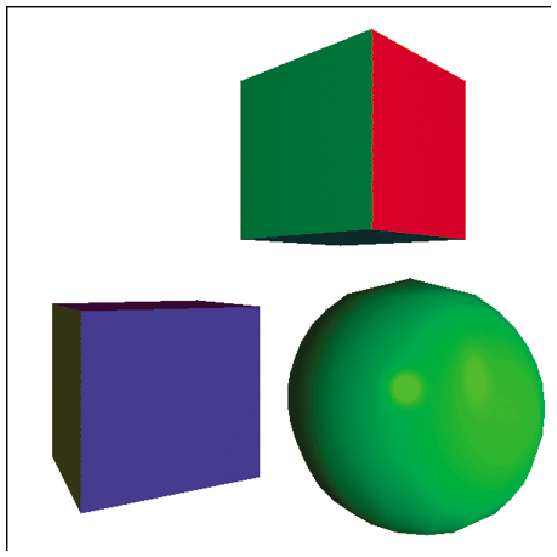
球体现在看起来好多了,它的表面显示出适当的曲率,镜面高光看起来很清晰。然而,它的轮廓仍然表明我们 正在渲染的是由三角形合成的近似效果。这不是着色算法的缺点,它只是决定三角形表面每个像素的颜色,而不能控制三角形本身的形状。可以使用更多的三角形 来获得更平滑的轮廓,但代价是性能下降。
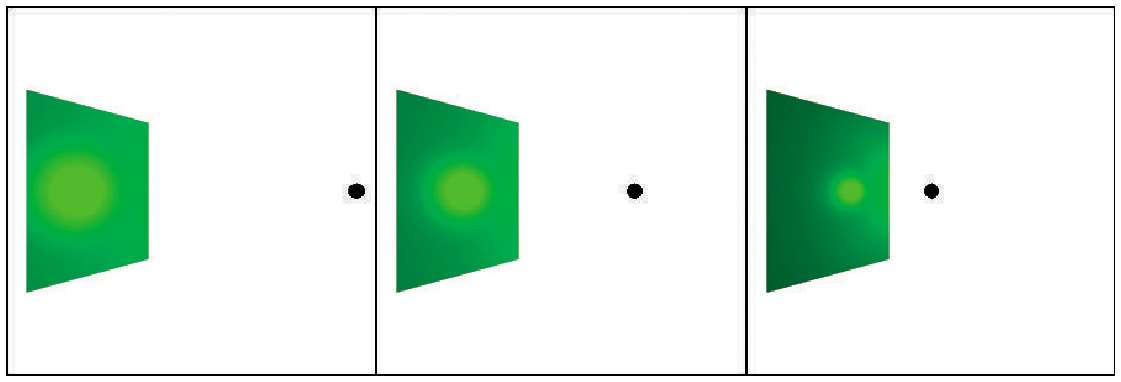
<!DOCTYPE html>
<html lang="en">
<head>
<meta charset="UTF-8">
<meta name="viewport" content="width=device-width, initial-scale=1.0">
<title>Lighting and Shading demo</title>
</head>
<body>
<div class="centered">
<canvas id="canvas" width=600 height=600 style="border: 1px grey solid"></canvas>
<table class="cgfs-demo-controls">
<tr>
<td><b>Lighting model</b></td>
<td class="text-left">
<input type="radio" id="lm-diffuse" name="lighting-model"
onClick="SetLightingModel(LM_DIFFUSE);"><label for="lm-diffuse">Diffuse only 仅漫射</label><br>
<input type="radio" id="lm-specular" name="lighting-model"
onClick="SetLightingModel(LM_SPECULAR);"><label for="lm-specular">Specular only
仅镜面反射</label><br>
<input type="radio" id="lm-both" name="lighting-model"
onClick="SetLightingModel(LM_DIFFUSE | LM_SPECULAR);" checked><label for="lm-both">Diffuse +
Specular 漫射+镜面反射</label>
</td>
</tr>
<tr>
<td><b>Shading model</b></td>
<td class="text-left">
<input type="radio" id="sm-flat" name="shading-model" onClick="SetShadingModel(SM_FLAT);"><label
for="sm-flat">Flat 扁平</label><br>
<input type="radio" id="sm-gouraud" name="shading-model"
onClick="SetShadingModel(SM_GOURAUD);"><label for="sm-gouraud">Gouraud 高洛德</label><br>
<input type="radio" id="sm-phong" name="shading-model" onClick="SetShadingModel(SM_PHONG);"
checked><label for="sm-phong">Phong 冯氏</label>
</td>
</tr>
<tr>
<td><b>Normals</b></td>
<td class="text-left">
<input type="radio" id="vn-off" name="vertex-normals" onClick="SetUseVertexNormals(false)"><label
for="vn-off">Computed triangle normals 计算三角形法线</label><br>
<input type="radio" id="vn-on" name="vertex-normals" onClick="SetUseVertexNormals(true)"
checked><label for="vn-on">Vertex normals from model 模型顶点法线</label>
</td>
</tr>
</table>
</div>
<script>
"use strict";
// ======================================================================
// Low-level canvas access.
// ======================================================================
let canvas = document.getElementById("canvas");
let canvas_context = canvas.getContext("2d");
let canvas_buffer = canvas_context.getImageData(0, 0, canvas.width, canvas.height);
// A color.
function Color(r, g, b) {
return {
r, g, b,
mul: function (n) { return new Color(this.r * n, this.g * n, this.b * n); },
};
}
// The PutPixel() function.
function PutPixel(x, y, color) {
x = canvas.width / 2 + (x | 0);
y = canvas.height / 2 - (y | 0) - 1;
if (x < 0 || x >= canvas.width || y < 0 || y >= canvas.height) {
return;
}
let offset = 4 * (x + canvas_buffer.width * y);
canvas_buffer.data[offset++] = color.r;
canvas_buffer.data[offset++] = color.g;
canvas_buffer.data[offset++] = color.b;
canvas_buffer.data[offset++] = 255; // Alpha = 255 (full opacity)
}
// Displays the contents of the offscreen buffer into the canvas.
function UpdateCanvas() {
canvas_context.putImageData(canvas_buffer, 0, 0);
}
// ======================================================================
// Depth buffer.
// ======================================================================
let depth_buffer = Array();
depth_buffer.length = canvas.width * canvas.height;
function UpdateDepthBufferIfCloser(x, y, inv_z) {
x = canvas.width / 2 + (x | 0);
y = canvas.height / 2 - (y | 0) - 1;
if (x < 0 || x >= canvas.width || y < 0 || y >= canvas.height) {
return false;
}
let offset = x + canvas.width * y;
if (depth_buffer[offset] == undefined || depth_buffer[offset] < inv_z) {
depth_buffer[offset] = inv_z;
return true;
}
return false;
}
function ClearAll() {
canvas.width = canvas.width;
depth_buffer = Array();
depth_buffer.length = canvas.width * canvas.height;
}
// ======================================================================
// Data model.
// ======================================================================
// A Point.
function Pt(x, y, h) {
return { x, y, h };
}
// A 3D vertex.
function Vertex(x, y, z) {
return {
x, y, z,
add: function (v) { return new Vertex(this.x + v.x, this.y + v.y, this.z + v.z); },
sub: function (v) { return new Vertex(this.x - v.x, this.y - v.y, this.z - v.z); },
mul: function (n) { return new Vertex(this.x * n, this.y * n, this.z * n); },
dot: function (vec) { return this.x * vec.x + this.y * vec.y + this.z * vec.z; },
length: function () { return Math.sqrt(this.dot(this)); },
}
}
// A 4D vertex (a 3D vertex in homogeneous coordinates).
function Vertex4(arg1, y, z, w) {
if (y == undefined) {
this.x = arg1.x;
this.y = arg1.y;
this.z = arg1.z;
this.w = arg1.w | 1;
} else {
this.x = arg1;
this.y = y;
this.z = z;
this.w = w;
}
this.add = function (v) { return new Vertex4(this.x + v.x, this.y + v.y, this.z + v.z); };
this.sub = function (v) { return new Vertex4(this.x - v.x, this.y - v.y, this.z - v.z, this.w - v.w); };
this.mul = function (n) { return new Vertex4(this.x * n, this.y * n, this.z * n, this.w); };
this.dot = function (vec) { return this.x * vec.x + this.y * vec.y + this.z * vec.z; };
this.cross = function (v2) { return new Vertex4(this.y * v2.z - this.z * v2.y, this.z * v2.x - this.x * v2.z, this.x * v2.y - this.y * v2.x); };
this.length = function () { return Math.sqrt(this.dot(this)); };
}
// A 4x4 matrix.
function Mat4x4(data) {
return { data };
}
const Identity4x4 = new Mat4x4([[1, 0, 0, 0], [0, 1, 0, 0], [0, 0, 1, 0], [0, 0, 0, 1]]);
// A Triangle.
function Triangle(indexes, color, normals) {
return { indexes, color, normals }
}
// A Model.
function Model(vertices, triangles, bounds_center, bounds_radius) {
return { vertices, triangles, bounds_center, bounds_radius };
}
// An Instance.
function Instance(model, position, orientation, scale) {
this.model = model;
this.position = position;
this.orientation = orientation || Identity4x4;
this.scale = scale || 1.0;
this.transform = MultiplyMM4(MakeTranslationMatrix(this.position), MultiplyMM4(this.orientation, MakeScalingMatrix(this.scale)));
}
// The Camera.
function Camera(position, orientation) {
this.position = position;
this.orientation = orientation;
this.clipping_planes = [];
}
// A Clipping Plane.
function Plane(normal, distance) {
return { normal, distance };
}
// A Light.
const LT_AMBIENT = 0;
const LT_POINT = 1;
const LT_DIRECTIONAL = 2;
function Light(type, intensity, vector) {
return { type, intensity, vector };
}
// ======================================================================
// Linear algebra and helpers.
// ======================================================================
// Makes a transform matrix for a rotation around the OY axis.
function MakeOYRotationMatrix(degrees) {
let cos = Math.cos(degrees * Math.PI / 180.0);
let sin = Math.sin(degrees * Math.PI / 180.0);
return new Mat4x4([[cos, 0, -sin, 0],
[0, 1, 0, 0],
[sin, 0, cos, 0],
[0, 0, 0, 1]])
}
// Makes a transform matrix for a translation.
function MakeTranslationMatrix(translation) {
return new Mat4x4([[1, 0, 0, translation.x],
[0, 1, 0, translation.y],
[0, 0, 1, translation.z],
[0, 0, 0, 1]]);
}
// Makes a transform matrix for a scaling.
function MakeScalingMatrix(scale) {
return new Mat4x4([[scale, 0, 0, 0],
[0, scale, 0, 0],
[0, 0, scale, 0],
[0, 0, 0, 1]]);
}
// Multiplies a 4x4 matrix and a 4D vector.
function MultiplyMV(mat4x4, vec4) {
let result = [0, 0, 0, 0];
let vec = [vec4.x, vec4.y, vec4.z, vec4.w];
for (let i = 0; i < 4; i++) {
for (let j = 0; j < 4; j++) {
result[i] += mat4x4.data[i][j] * vec[j];
}
}
return new Vertex4(result[0], result[1], result[2], result[3]);
}
// Multiplies two 4x4 matrices.
function MultiplyMM4(matA, matB) {
let result = new Mat4x4([[0, 0, 0, 0], [0, 0, 0, 0], [0, 0, 0, 0], [0, 0, 0, 0]]);
for (let i = 0; i < 4; i++) {
for (let j = 0; j < 4; j++) {
for (let k = 0; k < 4; k++) {
result.data[i][j] += matA.data[i][k] * matB.data[k][j];
}
}
}
return result;
}
// Transposes a 4x4 matrix.
function Transposed(mat) {
let result = new Mat4x4([[0, 0, 0, 0], [0, 0, 0, 0], [0, 0, 0, 0], [0, 0, 0, 0]]);
for (let i = 0; i < 4; i++) {
for (let j = 0; j < 4; j++) {
result.data[i][j] = mat.data[j][i];
}
}
return result;
}
// ======================================================================
// Rasterization code.
// ======================================================================
// Scene setup.
let viewport_size = 1;
let projection_plane_z = 1;
function Interpolate(i0, d0, i1, d1) {
if (i0 == i1) {
return [d0];
}
let values = [];
let a = (d1 - d0) / (i1 - i0);
let d = d0;
for (let i = i0; i <= i1; i++) {
values.push(d);
d += a;
}
return values;
}
function DrawLine(p0, p1, color) {
let dx = p1.x - p0.x, dy = p1.y - p0.y;
if (Math.abs(dx) > Math.abs(dy)) {
// The line is horizontal-ish. Make sure it's left to right.
if (dx < 0) { let swap = p0; p0 = p1; p1 = swap; }
// Compute the Y values and draw.
let ys = Interpolate(p0.x, p0.y, p1.x, p1.y);
for (let x = p0.x; x <= p1.x; x++) {
PutPixel(x, ys[(x - p0.x) | 0], color);
}
} else {
// The line is verical-ish. Make sure it's bottom to top.
if (dy < 0) { let swap = p0; p0 = p1; p1 = swap; }
// Compute the X values and draw.
let xs = Interpolate(p0.y, p0.x, p1.y, p1.x);
for (let y = p0.y; y <= p1.y; y++) {
PutPixel(xs[(y - p0.y) | 0], y, color);
}
}
}
function DrawWireframeTriangle(p0, p1, p2, color) {
DrawLine(p0, p1, color);
DrawLine(p1, p2, color);
DrawLine(p0, p2, color);
}
// Converts 2D viewport coordinates to 2D canvas coordinates.
function ViewportToCanvas(p2d) {
return new Pt(
p2d.x * canvas.width / viewport_size | 0,
p2d.y * canvas.height / viewport_size | 0);
}
// Converts 2D canvas coordinates to 2D viewport coordinates.
function CanvasToViewport(p2d) {
return new Pt(
p2d.x * viewport_size / canvas.width,
p2d.y * viewport_size / canvas.height);
}
function ProjectVertex(v) {
return ViewportToCanvas(new Pt(
v.x * projection_plane_z / v.z,
v.y * projection_plane_z / v.z));
}
function UnProjectVertex(x, y, inv_z) {
let oz = 1.0 / inv_z;
let ux = x * oz / projection_plane_z;
let uy = y * oz / projection_plane_z;
let p2d = CanvasToViewport(Pt(ux, uy));
return new Vertex(p2d.x, p2d.y, oz);
}
// Sort the points from bottom to top.
// Technically, sort the indexes to the vertex indexes in the triangle from bottom to top.
function SortedVertexIndexes(vertex_indexes, projected) {
let indexes = [0, 1, 2];
if (projected[vertex_indexes[indexes[1]]].y < projected[vertex_indexes[indexes[0]]].y) { let swap = indexes[0]; indexes[0] = indexes[1]; indexes[1] = swap; }
if (projected[vertex_indexes[indexes[2]]].y < projected[vertex_indexes[indexes[0]]].y) { let swap = indexes[0]; indexes[0] = indexes[2]; indexes[2] = swap; }
if (projected[vertex_indexes[indexes[2]]].y < projected[vertex_indexes[indexes[1]]].y) { let swap = indexes[1]; indexes[1] = indexes[2]; indexes[2] = swap; }
return indexes;
}
function ComputeTriangleNormal(v0, v1, v2) {
let v0v1 = v1.sub(v0);
let v0v2 = v2.sub(v0);
return v0v1.cross(v0v2);
}
function ComputeIllumination(vertex, normal, camera, lights) {
let illumination = 0;
for (let l = 0; l < lights.length; l++) {
let light = lights[l];
if (light.type == LT_AMBIENT) {
illumination += light.intensity;
continue;
}
let vl;
if (light.type == LT_DIRECTIONAL) {
let cameraMatrix = Transposed(camera.orientation);
let rotated_light = MultiplyMV(cameraMatrix, new Vertex4(light.vector));
vl = rotated_light;
} else if (light.type == LT_POINT) {
let cameraMatrix = MultiplyMM4(Transposed(camera.orientation), MakeTranslationMatrix(camera.position.mul(-1)));
let transformed_light = MultiplyMV(cameraMatrix, new Vertex4(light.vector));
vl = vertex.mul(-1).add(transformed_light);
}
// Diffuse component.
if (LightingModel & LM_DIFFUSE) {
let cos_alpha = vl.dot(normal) / (vl.length() * normal.length());
if (cos_alpha > 0) {
illumination += cos_alpha * light.intensity;
}
}
// Specular component.
if (LightingModel & LM_SPECULAR) {
let reflected = normal.mul(2 * normal.dot(vl)).sub(vl);
let view = camera.position.sub(vertex);
let cos_beta = reflected.dot(view) / (reflected.length() * view.length());
if (cos_beta > 0) {
let specular = 50;
illumination += Math.pow(cos_beta, specular) * light.intensity;
}
}
}
return illumination;
}
const LM_DIFFUSE = 1;
const LM_SPECULAR = 2;
const SM_FLAT = 0;
const SM_GOURAUD = 1;
const SM_PHONG = 2;
let LightingModel = LM_DIFFUSE | LM_SPECULAR;
let ShadingModel = SM_PHONG;
let UseVertexNormals = true;
function EdgeInterpolate(y0, v0, y1, v1, y2, v2) {
let v01 = Interpolate(y0, v0, y1, v1);
let v12 = Interpolate(y1, v1, y2, v2);
let v02 = Interpolate(y0, v0, y2, v2);
v01.pop();
let v012 = v01.concat(v12);
return [v02, v012];
}
function RenderTriangle(triangle, vertices, projected, camera, lights, orientation) {
// Sort by projected point Y.
let indexes = SortedVertexIndexes(triangle.indexes, projected);
let [i0, i1, i2] = indexes;
let v0 = vertices[triangle.indexes[i0]];
let v1 = vertices[triangle.indexes[i1]];
let v2 = vertices[triangle.indexes[i2]];
// Compute triangle normal. Use the unsorted vertices, otherwise the winding of the points may change.
let normal = ComputeTriangleNormal(vertices[triangle.indexes[0]], vertices[triangle.indexes[1]], vertices[triangle.indexes[2]]);
// Backface culling.
let vertex_to_camera = vertices[triangle.indexes[0]].mul(-1); // Should be Subtract(camera.position, vertices[triangle.indexes[0]])
if (vertex_to_camera.dot(normal) <= 0) {
return;
}
// Get attribute values (X, 1/Z) at the vertices.
let p0 = projected[triangle.indexes[i0]];
let p1 = projected[triangle.indexes[i1]];
let p2 = projected[triangle.indexes[i2]];
// Compute attribute values at the edges.
let [x02, x012] = EdgeInterpolate(p0.y, p0.x, p1.y, p1.x, p2.y, p2.x);
let [iz02, iz012] = EdgeInterpolate(p0.y, 1.0 / v0.z, p1.y, 1.0 / v1.z, p2.y, 1.0 / v2.z);
if (UseVertexNormals) {
let transform = MultiplyMM4(Transposed(camera.orientation), orientation);
var normal0 = MultiplyMV(transform, new Vertex4(triangle.normals[i0]));
var normal1 = MultiplyMV(transform, new Vertex4(triangle.normals[i1]));
var normal2 = MultiplyMV(transform, new Vertex4(triangle.normals[i2]));
} else {
var normal0 = normal;
var normal1 = normal;
var normal2 = normal;
}
let intensity;
if (ShadingModel == SM_FLAT) {
// Flat shading: compute lighting for the entire triangle.
let center = Vertex((v0.x + v1.x + v2.x) / 3.0, (v0.y + v1.y + v2.y) / 3.0, (v0.z + v1.z + v2.z) / 3.0);
intensity = ComputeIllumination(center, normal0, camera, lights);
} else if (ShadingModel == SM_GOURAUD) {
// Gouraud shading: compute lighting at the vertices, and interpolate.
let i0 = ComputeIllumination(v0, normal0, camera, lights);
let i1 = ComputeIllumination(v1, normal1, camera, lights);
let i2 = ComputeIllumination(v2, normal2, camera, lights);
var [i02, i012] = EdgeInterpolate(p0.y, i0, p1.y, i1, p2.y, i2);
} else if (ShadingModel == SM_PHONG) {
// Phong shading: interpolate normal vectors.
var [nx02, nx012] = EdgeInterpolate(p0.y, normal0.x, p1.y, normal1.x, p2.y, normal2.x);
var [ny02, ny012] = EdgeInterpolate(p0.y, normal0.y, p1.y, normal1.y, p2.y, normal2.y);
var [nz02, nz012] = EdgeInterpolate(p0.y, normal0.z, p1.y, normal1.z, p2.y, normal2.z);
}
// Determine which is left and which is right.
let m = (x02.length / 2) | 0;
if (x02[m] < x012[m]) {
var [x_left, x_right] = [x02, x012];
var [iz_left, iz_right] = [iz02, iz012];
var [i_left, i_right] = [i02, i012];
var [nx_left, nx_right] = [nx02, nx012];
var [ny_left, ny_right] = [ny02, ny012];
var [nz_left, nz_right] = [nz02, nz012];
} else {
var [x_left, x_right] = [x012, x02];
var [iz_left, iz_right] = [iz012, iz02];
var [i_left, i_right] = [i012, i02];
var [nx_left, nx_right] = [nx012, nx02];
var [ny_left, ny_right] = [ny012, ny02];
var [nz_left, nz_right] = [nz012, nz02];
}
// Draw horizontal segments.
for (let y = p0.y; y <= p2.y; y++) {
let [xl, xr] = [x_left[y - p0.y] | 0, x_right[y - p0.y] | 0];
// Interpolate attributes for this scanline.
let [zl, zr] = [iz_left[y - p0.y], iz_right[y - p0.y]];
let zscan = Interpolate(xl, zl, xr, zr);
let iscan, nxscan, nyscan, nzscan;
if (ShadingModel == SM_GOURAUD) {
let [il, ir] = [i_left[y - p0.y], i_right[y - p0.y]];
iscan = Interpolate(xl, il, xr, ir);
} else if (ShadingModel == SM_PHONG) {
let [nxl, nxr] = [nx_left[y - p0.y], nx_right[y - p0.y]];
let [nyl, nyr] = [ny_left[y - p0.y], ny_right[y - p0.y]];
let [nzl, nzr] = [nz_left[y - p0.y], nz_right[y - p0.y]];
nxscan = Interpolate(xl, nxl, xr, nxr);
nyscan = Interpolate(xl, nyl, xr, nyr);
nzscan = Interpolate(xl, nzl, xr, nzr);
}
for (let x = xl; x <= xr; x++) {
let inv_z = zscan[x - xl];
if (UpdateDepthBufferIfCloser(x, y, inv_z)) {
if (ShadingModel == SM_FLAT) {
// Just use the per-triangle intensity.
} else if (ShadingModel == SM_GOURAUD) {
intensity = iscan[x - xl];
} else if (ShadingModel == SM_PHONG) {
let vertex = UnProjectVertex(x, y, inv_z);
let normal = Vertex(nxscan[x - xl], nyscan[x - xl], nzscan[x - xl]);
intensity = ComputeIllumination(vertex, normal, camera, lights);
}
PutPixel(x, y, triangle.color.mul(intensity));
}
}
}
}
// Clips a triangle against a plane. Adds output to triangles and vertices.
function ClipTriangle(triangle, plane, triangles, vertices) {
let v0 = vertices[triangle.indexes[0]];
let v1 = vertices[triangle.indexes[1]];
let v2 = vertices[triangle.indexes[2]];
let in0 = plane.normal.dot(v0) + plane.distance > 0;
let in1 = plane.normal.dot(v1) + plane.distance > 0;
let in2 = plane.normal.dot(v2) + plane.distance > 0;
let in_count = in0 + in1 + in2;
if (in_count == 0) {
// Nothing to do - the triangle is fully clipped out.
} else if (in_count == 3) {
// The triangle is fully in front of the plane.
triangles.push(triangle);
} else if (in_count == 1) {
// The triangle has one vertex in. Output is one clipped triangle.
} else if (in_count == 2) {
// The triangle has two vertices in. Output is two clipped triangles.
}
}
function TransformAndClip(clipping_planes, model, scale, transform) {
// Transform the bounding sphere, and attempt early discard.
let center = MultiplyMV(transform, new Vertex4(model.bounds_center));
let radius = model.bounds_radius * scale;
for (let p = 0; p < clipping_planes.length; p++) {
let distance = clipping_planes[p].normal.dot(center) + clipping_planes[p].distance;
if (distance < -radius) {
return null;
}
}
// Apply modelview transform.
let vertices = [];
for (let i = 0; i < model.vertices.length; i++) {
vertices.push(MultiplyMV(transform, new Vertex4(model.vertices[i])));
}
// Clip the entire model against each successive plane.
let triangles = model.triangles.slice();
for (let p = 0; p < clipping_planes.length; p++) {
let new_triangles = []
for (let i = 0; i < triangles.length; i++) {
ClipTriangle(triangles[i], clipping_planes[p], new_triangles, vertices);
}
triangles = new_triangles;
}
return Model(vertices, triangles, center, model.bounds_radius);
}
function RenderModel(model, camera, lights, orientation) {
let projected = [];
for (let i = 0; i < model.vertices.length; i++) {
projected.push(ProjectVertex(new Vertex4(model.vertices[i])));
}
for (let i = 0; i < model.triangles.length; i++) {
RenderTriangle(model.triangles[i], model.vertices, projected, camera, lights, orientation);
}
}
function RenderScene(camera, instances, lights) {
let cameraMatrix = MultiplyMM4(Transposed(camera.orientation), MakeTranslationMatrix(camera.position.mul(-1)));
for (let i = 0; i < instances.length; i++) {
let transform = MultiplyMM4(cameraMatrix, instances[i].transform);
let clipped = TransformAndClip(camera.clipping_planes, instances[i].model, instances[i].scale, transform);
if (clipped != null) {
RenderModel(clipped, camera, lights, instances[i].orientation);
}
}
}
// ----- Sphere model generator -----
function GenerateSphere(divs, color) {
let vertices = [];
let triangles = [];
let delta_angle = 2.0 * Math.PI / divs;
// Generate vertices and normals.
for (let d = 0; d < divs + 1; d++) {
let y = (2.0 / divs) * (d - divs / 2);
let radius = Math.sqrt(1.0 - y * y);
for (let i = 0; i < divs; i++) {
let vertex = new Vertex(radius * Math.cos(i * delta_angle), y, radius * Math.sin(i * delta_angle));
vertices.push(vertex);
}
}
// Generate triangles.
for (let d = 0; d < divs; d++) {
for (let i = 0; i < divs; i++) {
let i0 = d * divs + i;
let i1 = (d + 1) * divs + (i + 1) % divs;
let i2 = divs * d + (i + 1) % divs;
let tri0 = [i0, i1, i2];
let tri1 = [i0, i0 + divs, i1];
triangles.push(Triangle(tri0, color, [vertices[tri0[0]], vertices[tri0[1]], vertices[tri0[2]]]));
triangles.push(Triangle(tri1, color, [vertices[tri1[0]], vertices[tri1[1]], vertices[tri1[2]]]));
}
}
return new Model(vertices, triangles, new Vertex(0, 0, 0), 1.0);
}
// ----- Cube model -----
const vertices = [
new Vertex(1, 1, 1),
new Vertex(-1, 1, 1),
new Vertex(-1, -1, 1),
new Vertex(1, -1, 1),
new Vertex(1, 1, -1),
new Vertex(-1, 1, -1),
new Vertex(-1, -1, -1),
new Vertex(1, -1, -1)
];
const RED = new Color(255, 0, 0);
const GREEN = new Color(0, 255, 0);
const BLUE = new Color(0, 0, 255);
const YELLOW = new Color(255, 255, 0);
const PURPLE = new Color(255, 0, 255);
const CYAN = new Color(0, 255, 255);
const triangles = [
new Triangle([0, 1, 2], RED, [new Vertex(0, 0, 1), new Vertex(0, 0, 1), new Vertex(0, 0, 1)]),
new Triangle([0, 2, 3], RED, [new Vertex(0, 0, 1), new Vertex(0, 0, 1), new Vertex(0, 0, 1)]),
new Triangle([4, 0, 3], GREEN, [new Vertex(1, 0, 0), new Vertex(1, 0, 0), new Vertex(1, 0, 0)]),
new Triangle([4, 3, 7], GREEN, [new Vertex(1, 0, 0), new Vertex(1, 0, 0), new Vertex(1, 0, 0)]),
new Triangle([5, 4, 7], BLUE, [new Vertex(0, 0, -1), new Vertex(0, 0, -1), new Vertex(0, 0, -1)]),
new Triangle([5, 7, 6], BLUE, [new Vertex(0, 0, -1), new Vertex(0, 0, -1), new Vertex(0, 0, -1)]),
new Triangle([1, 5, 6], YELLOW, [new Vertex(-1, 0, 0), new Vertex(-1, 0, 0), new Vertex(-1, 0, 0)]),
new Triangle([1, 6, 2], YELLOW, [new Vertex(-1, 0, 0), new Vertex(-1, 0, 0), new Vertex(-1, 0, 0)]),
new Triangle([1, 0, 5], PURPLE, [new Vertex(0, 1, 0), new Vertex(0, 1, 0), new Vertex(0, 1, 0)]),
new Triangle([5, 0, 4], PURPLE, [new Vertex(0, 1, 0), new Vertex(0, 1, 0), new Vertex(0, 1, 0)]),
new Triangle([2, 6, 7], CYAN, [new Vertex(0, -1, 0), new Vertex(0, -1, 0), new Vertex(0, -1, 0)]),
new Triangle([2, 7, 3], CYAN, [new Vertex(0, -1, 0), new Vertex(0, -1, 0), new Vertex(0, -1, 0)]),
];
let cube = new Model(vertices, triangles, new Vertex(0, 0, 0), Math.sqrt(3));
const sphere = GenerateSphere(15, GREEN);
let instances = [
new Instance(cube, new Vertex(-1.5, 0, 7), Identity4x4, 0.75),
new Instance(cube, new Vertex(1.25, 2.5, 7.5), MakeOYRotationMatrix(195)),
new Instance(sphere, new Vertex(1.75, -0.5, 7), Identity4x4, 1.5),
];
const camera = new Camera(new Vertex(-3, 1, 2), MakeOYRotationMatrix(-30));
let s2 = 1.0 / Math.sqrt(2);
camera.clipping_planes = [
new Plane(new Vertex(0, 0, 1), -1), // Near
new Plane(new Vertex(s2, 0, s2), 0), // Left
new Plane(new Vertex(-s2, 0, s2), 0), // Right
new Plane(new Vertex(0, -s2, s2), 0), // Top
new Plane(new Vertex(0, s2, s2), 0), // Bottom
];
const lights = [
new Light(LT_AMBIENT, 0.2),
new Light(LT_DIRECTIONAL, 0.2, Vertex(-1, 0, 1)),
new Light(LT_POINT, 0.6, Vertex(-3, 2, -10))
];
// ----- For the "wrong Gouraud interpolation" image -----
/*
let camera = Camera(Vertex(0, 0, 0), Identity4x4);
let light_position = Vertex(2.25, 0, 5);
//let light_position = Vertex(1, 0, 5);
//let light_position = Vertex(0, 0, 5);
lights = [
new Light(LT_AMBIENT, 0.2),
new Light(LT_POINT, 0.6, light_position)
];
let triangles = [
new Triangle([4, 0, 3], GREEN, [Vertex(1, 0, 0), Vertex(1, 0, 0), Vertex(1, 0, 0)]),
new Triangle([4, 3, 7], GREEN, [Vertex(1, 0, 0), Vertex(1, 0, 0), Vertex(1, 0, 0)]),
];
let light_source = GenerateSphere(15, YELLOW);
let face = Model(vertices, triangles, Vertex(0, 0, 0), Math.sqrt(3));
let instances = [
Instance(light_source, light_position, Identity4x4, 0.1),
Instance(face, Vertex(-2, 0, 5), MakeOYRotationMatrix(-30), 1),
];
*/
// -----------------------------------------------------
function SetLightingModel(model) {
LightingModel = model;
Render();
}
function SetShadingModel(model) {
ShadingModel = model;
Render();
}
function SetUseVertexNormals(use_vertex_normals) {
UseVertexNormals = use_vertex_normals;
Render();
}
function Render() {
ClearAll();
// This lets the browser clear the canvas before blocking to render the scene.
setTimeout(function () {
RenderScene(camera, instances, lights);
UpdateCanvas();
}, 0);
}
Render();
</script>
</body>
</html>